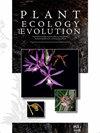A new species of Parianella (Poaceae, Bambusoideae, Olyreae) marks the southernmost distribution of the genus in Brazil
IF 1.1
4区 生物学
Q3 PLANT SCIENCES
引用次数: 0
Abstract
Background and aims – Parianella is a relatively recently described genus of the subtribe Parianinae (Poaceae, Bambusoideae, Olyreae) that includes two species, and it is supposedly endemic to the Bahian Coastal Forests in the central region of Atlantic Forest, Brazil. Herein, we describe and illustrate a new species of the genus, comparing it with the other species of Parianella. We also provide an updated distribution map of the genus and the conservation status of the new taxon. Material and methods – This study was based on the analysis of herbarium specimens and a literature review. The conservation assessment is based on field observations and spatial analyses, following IUCN guidelines and criteria. Key results – During a review of the Poaceae collection of the MBML Herbarium, two Parianinae specimens with interesting features were found. A detailed morphological analysis revealed that these specimens belong to a new species of Parianella. The new taxon was collected in two localities in the southern portion of the Brazilian state of Espírito Santo, one in the municipality of Santa Leopoldina and the other in the Duas Bocas Biological Reserve, municipality of Cariacica. Both localities are situated in the Krenák-Waitaká Forests, one of the three subregions of the central Atlantic Forest region, and an area of great floristic diversity, including bamboo species. Conclusion – Parianella capixaba represents the southernmost distribution of the genus known to date. With the description of this new species, the total number of bamboos in Espírito Santo state rises to 52 species in 18 genera.一新种(竹科,竹总科,竹科)标志着该属在巴西最南端的分布
背景和目的- Parianella是Parianinae亚部落(Poaceae, Bambusoideae, Olyreae)中一个最近被描述的属,包括两个物种,它被认为是巴西大西洋森林中部地区巴伊安沿海森林的特有物种。在此,我们描述和说明了一个新种的属,并与其他种的Parianella比较。我们还提供了该属的最新分布图和新分类单元的保护状况。材料和方法:本研究基于对植物标本馆标本的分析和文献综述。保护评估是基于实地观察和空间分析,遵循世界自然保护联盟的指导方针和标准。主要结果-在对MBML标本室的禾本科藏品进行审查时,发现了两个具有有趣特征的Parianinae标本。详细的形态分析表明这些标本属于Parianella的一个新种。该新分类群是在巴西Espírito Santo州南部的两个地方收集的,一个在Santa Leopoldina市,另一个在Cariacica市的Duas Bocas生物保护区。这两个地方都位于Krenák-Waitaká森林,这是大西洋中部森林区域的三个分区域之一,也是一个植物多样性很大的地区,包括竹子物种。结论:Parianella capixaba代表了迄今为止已知的该属最南端的分布。随着这一新种的描述,Espírito桑托州的竹子总数增加到18属52种。
本文章由计算机程序翻译,如有差异,请以英文原文为准。
求助全文
约1分钟内获得全文
求助全文
来源期刊

Plant Ecology and Evolution
PLANT SCIENCES-
CiteScore
2.20
自引率
9.10%
发文量
27
审稿时长
>12 weeks
期刊介绍:
Plant Ecology and Evolution is an international peer-reviewed journal devoted to ecology, phylogenetics and systematics of all ‘plant’ groups in the traditional sense (including algae, cyanobacteria, fungi, myxomycetes), also covering related fields.
The journal is published by Meise Botanic Garden and the Royal Botanical Society of Belgium.
 求助内容:
求助内容: 应助结果提醒方式:
应助结果提醒方式:


